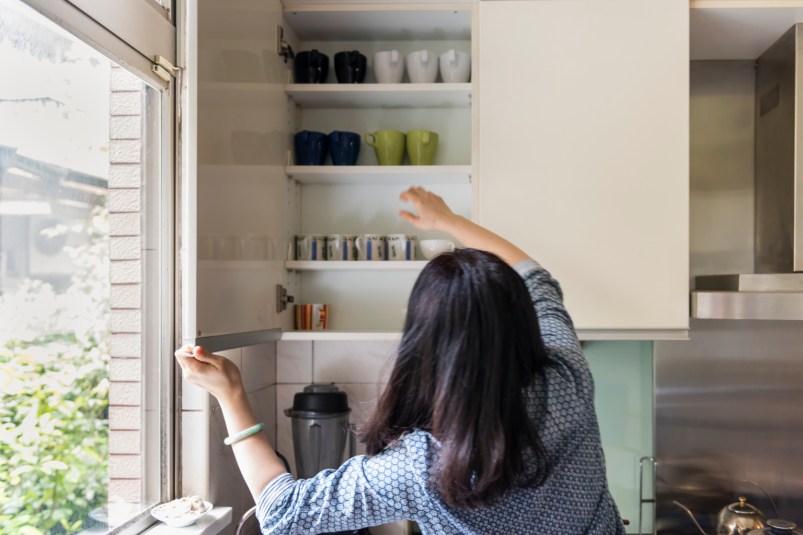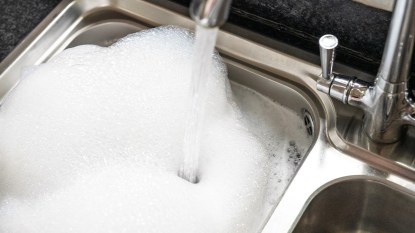Home
35 Kitchen Storage Tips to Create More Space

One of the most common frustrations in the kitchen is minimal storage. There’s a common misconception that if you’re not in a position to buy a whole new kitchen at vast expense, then there’s little you can do to improve your storage situation. Nothing could be further from the truth. Check out our tips and ideas for better storage in your kitchen.
Where to start.
Success lies in planning. Before investing in any new kitchen storage cabinetry or accessories, consider:
- How do you use the kitchen? For example, where do you prepare your food? Clean up? Recycle? You should be able to move around your kitchen easily and comfortably and be able to find what you’re looking for in an instant.
- What do you actually need to store? As with every other organizational overhaul, it makes sense to give the kitchen a good declutter first so that you can work out exactly what you need to store and what’s just causing unnecessary clutter in the kitchen.
- What do you need to keep out on display and what can you keep hidden away? Any electrical appliances such as blenders or juicers that are only used occasionally can be stored up high or out of the kitchen altogether, freeing up precious surface space.
- Where can you find additional storage space? Look for all those hidden opportunities, such as overhead, on the walls, in the corners of rooms, and behind cabinetry.
Top tips for better kitchen storage.
- Where should you put your kitchen accessories? A good rule of thumb is that the items you use most often should be positioned just above or below bench height, while the things you use the least often should be placed at the very highest and lowest points in the kitchen design. Those you use only occasionally can be stored outside the kitchen altogether.
- Avoid bending and stretching for the items you reach for all the time. When you’re planning your kitchen storage, base it around the height of the person who uses the kitchen the most often.
- Remember that kitchen storage doesn’t stop at cabinets – it also includes hooks, racks, containers, drawer dividers, and more. Many are cheap and easy to incorporate into your existing kitchen.
- When assessing your own storage potential, think vertically as well as horizontally. Store awkward items such as pot lids, extra plates, and baking trays in wall racks or vertical slots within your cabinetry.
- Make things easier to reach by reversing traditional positions. Why not put frequently-used ingredients under the counter where you’d traditionally store saucepans, and hang your pans above an island.
- Rather than delving into your storage, ideally, it should come to you. The current trend replaces traditional cabinets with fully-extending drawers and pull-out systems that come directly to you.
- Don’t overlook ergonomics. Look for wide-opening hinges, smooth-closing doors, and slam-proof drawers that are a pleasure to use.
- Kitchen lighting is important — you should be able to see into all the dark recesses of cupboards and drawers. Look for under-cabinet lighting strips to brighten bench-tops and lights that turn on automatically when a cupboard door is opened.
Kitchen storage ideas.
- Keep your countertops clear by storing bulky everyday appliances such as the toaster and coffee maker behind a sliding or rolling screen.
- Look to your walls for extra storage — you can now wall-mount everything from your microwave and knives to condiments and spices.
- Be creative — use the undersides of wall cabinets to mount accessories such as the paper towel or clingwrap holder — it not only clears precious counter space but means they are always within easy reach.
- Keep the pages of your cookbook open and free from greasy spills by using a fold-down cookbook holder.
- While most of us can boast a fairly well-organized cutlery drawer, the utensil drawer beneath it is often a jumbled mess. Create an order with a drawer divider and organizer.
- Choose full-extension drawers and pull-outs so that you can see what’s inside the whole drawer, rather than peering into the dark recesses of old-fashioned drawers and cabinets for that elusive paring knife or garlic crusher.
- Dish drawers with pegs or moveable holders are an invaluable asset in the kitchen. They keep everything firmly in place and can be shifted around to fit the exact dimensions of your plates, which means no more delving around in the backs of cupboards for that extra place setting.
- Look out for swing shelves and pull-out wire baskets that can create handy storage from those notoriously awkward spots in the kitchen, such as corners of cabinets.
- A pull-out pantry with wire sides that prevent items from falling out is easy to use and allows you to see when you’re running low on stocks.
- You don’t have to buy a whole new kitchen to improve the way it feels to use — you can now buy inexpensive, soft-closing devices so that your drawers and cupboard doors won’t slam, making them safer and more pleasant to use.
- Use wasted airspace above the island unit for a hanging rack, but make sure that you position it carefully so that you don’t bump your head into pots and pans. Lids can be stored separately on a vertical lid-rack on the wall.
- Create extra storage for all those smaller items such as mugs, ladles, and spice jars with wall hooks and baskets.
- Storage containers should be the correct size to hold the ingredients, look good on display, and allow you to easily see when you’re running low on stocks. Transparent, square-edged containers are a very practical choice — they fit together and stack with ease, make great use of space, plus you can see exactly what’s inside.
- Make recycling easier and more efficient — position four separate bins under the kitchen sink or by the kitchen door.
- Even novice chefs face occasions when they need to plug in more than one electrical appliance at once, and there’s nothing more irritating than finding yourself short of power points or discovering that the cord doesn’t quite reach far enough. The solution? A wall-mountable power cord rail that allows you to plug in as many appliances as you want, anywhere along the track.
- If you’re designing a whole or part of your kitchen from scratch, think about how you move around it. Save time and hassle by installing a built-in butcher’s block in your prep area with a bin right below it to clear away scraps.
- Adjustable shelving is a more practical choice than fixed shelving as it can easily be moved around to accommodate all those bottles and jars, or simply removed altogether when not required.
- Large empty cupboards can provide very inefficient storage, particularly if you have a lot of smaller items to store. Make the most of large spaces by adding wire shelf racks — they’re inexpensive, mobile, and can store a multitude of items across several different layers.
- Don’t forget the backs of doors — attach hooks or rails to hold all those little kitchen extras such as extension cords, aprons, or tea towels.
- An island unit on castors that fits neatly beneath a countertop when not in use provides extra storage and a handy work surface.
- Use every centimeter of available space, and make sure your cabinetry goes right from the floor to the ceiling. Infrequently used appliances can be stored up high, and the toe-kick space near the floor is the perfect spot for old papers for recycling or rarely-used table linens.
- Add shelves to the end of an island unit to store cookbooks or for a wine cubby.
- If you have space, a window seat provides a cozy eating spot within the kitchen, plus it gives you additional storage. Opt for slide-out drawers rather than a hinged top as they’ll give you better-organized storage space, and will eliminate the need for delving around the dark recesses of a cubby hole when you’re looking for an item.
This article originally appeared on our sister site, Homes to Love.













